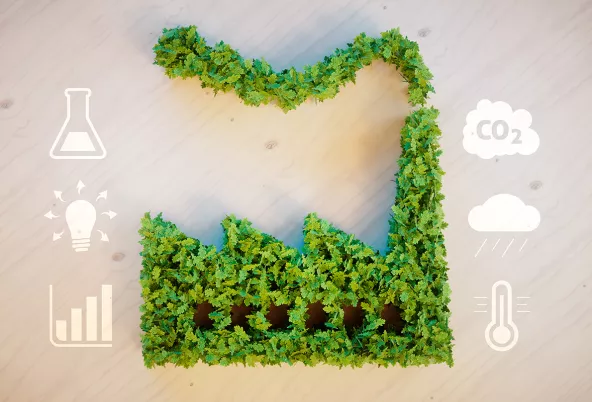When we recognised that our market was struggling to differentiate between environmentally ‘clean’ products and others, we set out to find a third-party product standard that would ensure that our products with better environmental performance could be easily differentiated from others on the market.
Short biography
Deepthi Kurian is the Sustainability & Product Stewardship Specialist at AGC Glass Europe. She has more than 15 years of experience in sustainability, including chemical compliance of products/materials, and product stewardship in various industries. She has worked in India and Europe, as well as on-site at projects in Japan and the US, for customers around the world. She holds a degree in Chemical Engineering and a Master’s in Polymer Technology from CUSAT, India.
"AGC’s motto is “clean manufacturing of sustainable products”. That means we produce environmentally friendly products through an environmentally friendly process. Our driving principle is to develop products with a positive impact on the environment during their lifetime.
When we recognised that our market was struggling to differentiate between environmentally ‘clean’ products and others, we set out to find a third-party product standard that would ensure that our products with better environmental performance could be easily differentiated from others on the market. Cradle to Cradle CertifiedTM presented a clear solution. The standard includes the construction industry (for instance, the EU Ecolabel does not include glass) and no other label covered as many aspects of sustainability: material health, material reutilisation, energy and water management, and social fairness. The fact that Cradle to Cradle CertifiedTM is also a global certification was also compelling compared to other, regional standards.
We were the first European glass manufacturer to implement Cradle to Cradle CertifiedTM. Because the market has responded so positively to our products being differentiated from others in this way, more than 75% of our products are now Cradle to Cradle CertifiedTM."

"On the supply side, we have worked hand-in-hand with suppliers to optimise their products so that they meet our environmental performance requirements. Our achievements in Cradle to Cradle certification give us more leverage in asking suppliers for improvements in their products so as to meet even higher Cradle to Cradle certification requirements. The certification of our insulating glazing is a good example of this. We engaged 20 different suppliers in order to meet the criteria for the material composition. This process was quite challenging, but it helps us build customer trust.
From a customer perspective, architects increasingly want products that guarantee the sustainability of their projects. With Cradle to Cradle CertifiedTM products, they know that they can deliver on this guarantee, plus earn higher ratings when seeking green building certifications such as LEED."

"Expanding our number of Cradle to Cradle CertifiedTM products has resulted in a number of internal benefits for us. For instance, collaboration with internal stakeholders for data collection has become more flexible and stronger. In addition, our plants and other stakeholders have become more aware of Cradle to Cradle CertifiedTM requirements and how they enable us to design and make products that have a positive impact on the environment. In fact, Cradle to Cradle requirements are also incorporated into our Research and Development (R&D) methodology, ensuring that our R&D, Sales & Marketing, and Sustainability departments work hand-in-hand on developing, producing and bringing Cradle to Cradle CertifiedTM products to market."
Using the Cradle to Cradle CertifiedTM Product Standard to certify our products supports our commitment to continuous improvement by providing us with a framework for optimising our products for environmental performance.
"Transitioning products from certification under Cradle to Cradle CertifiedTM versions 1 and 2 to version 3 is a powerful example of this. Indeed, there were tremendous changes between the two first versions and the third one, so re-certifying our products according to the requirements of Cradle to Cradle CertifiedTM version 3 was quite challenging for our teams. But we rose to the challenge and working with version 3 pushed us to make some optimisations that resulted in measurable improvements and led to better certification levels. For example, our laminated glass was first certified at Bronze level under version 3 but, thanks to collaboration with suppliers that improved the material health of the product, we were ultimately able to reach Silver level. When developing our new mirrors, we immediately worked on the areas that prevented us from getting a better certification with our standard product. This is how our Mirox 4Green was able to reach Silver certification.
Cradle to Cradle certification has also played a critical role in helping optimise our organisation’s environmental performance as well as the environmental performance of individual products: We aim to be at the forefront of developing new products with better environmental performance during their lifetime, and trying to improve our products and processes is part of our sustainability strategy: 50% of our R&D budget is devoted to sustainable solutions.
Since 1998, we have managed to reduce the quantity of production waste sent to landfill by 95% on a like-for-like basis. In 2019, our landfill waste was 1.7%, which means 98.3% of material previously considered waste was recycled. For each tonne of CO2 emitted by AGC Glass Europe activity, nearly 11 tonnes of CO2 are avoided thanks to our energy-saving products. In addition, from 1998 to 2019 we managed to reduce water consumption by 73% on a like-for-like basis."

"One of the challenges we face as we look ahead is that, as an energy-intensive industry, we cannot rely only on renewable energy sources to heat our furnaces - even if we limit the impact of our industrial activities as much as possible. This is the reality we have to face. The development process for version 4 of the Cradle to Cradle CertifiedTM Product Standard is helping to shine a light on this challenge - and how industries like ours may require options for meeting decarbonisation requirements that consider the amount of CO2 saved by the use of our products. With this in mind, we are actively working in accordance with the EU’s decarbonisation agenda and are also taking part in the EU’s Emissions Trading Scheme."

